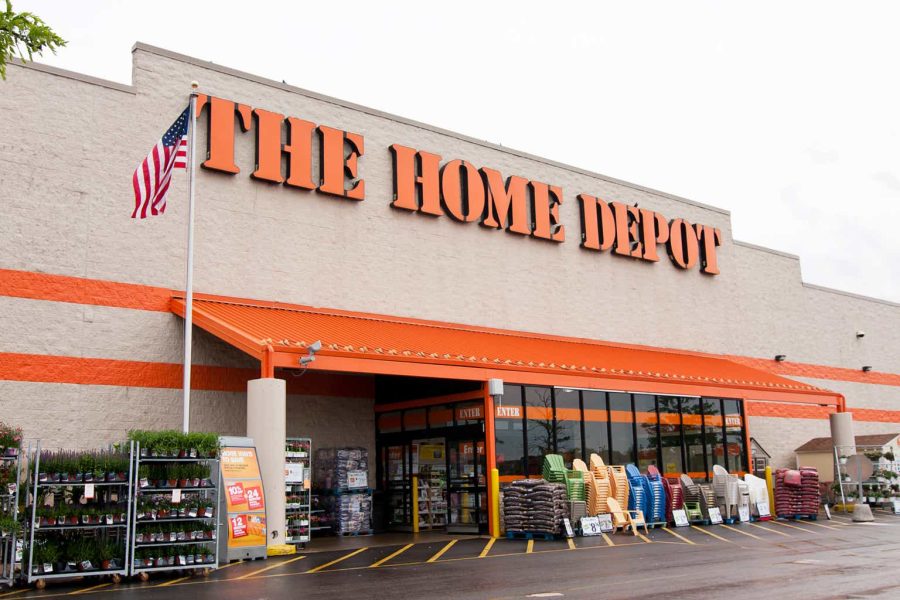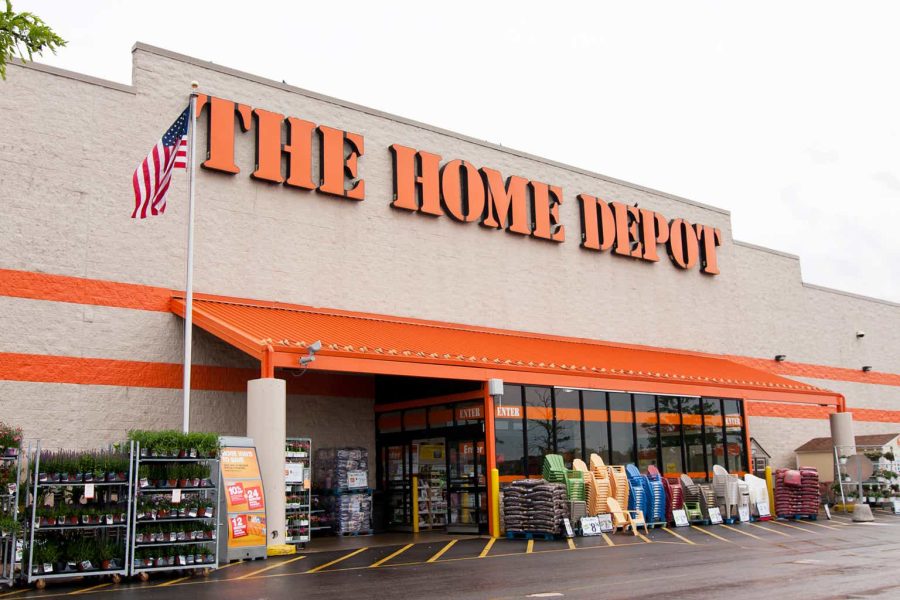July 14, 2024 This Week Top S&P 500 Gainers & Losers
Tesla: Time To Take Profits
Microsoft: The Q4 Results Should Surprise You
Tesla: Optimus And FSD Probably Won’t Save The Day
April 23, 2024 Maximizing Profits: When is the Right Time to Sell Your Business?
April 12, 2024 Improve Your Financial Status: A How-To Guide
April 12, 2024 How ZIM Integrated Container Tracking is Revolutionizing Global Trade
March 15, 2024 6 Best Growth Stocks To Buy Now According to Metatrader 5

The Home Depot (HD) Stock Forecast for 2024–2028. Sell or Buy?
Updated: July 26, 2024 (22:08)
Sector: Consumer cyclicalThe share price of The Home Depot, Inc. (HD) now
50/200 Day Moving Average: $342.99 / $340.43
This figure corresponds to the Average Price over the previous 50/200 days. For The Home Depot stocks, the 50-day moving average is the support level today.
For The Home Depot stocks, the 200-day moving average is the support level today.
Are you interested in The Home Depot, Inc. stocks and want to buy them, or are they already in your portfolio? If yes, then on this page you will find useful information about the dynamics of the The Home Depot stock price in 2024, 2025, 2026, 2027, 2028. How much will one The Home Depot share be worth in 2024 - 2028?
When should I take profit in The Home Depot stock? When should I record a loss on The Home Depot stock? What are analysts' forecasts for The Home Depot stock? What is the future of The Home Depot stock? We forecast The Home Depot stock performance using neural networks based on historical data on The Home Depot stocks. Also, when forecasting, technical analysis tools are used, world geopolitical and news factors are taken into account.
The Home Depot stock prediction results are shown below and presented in the form of graphs, tables and text information, divided into time intervals. (Next month, 2024, 2025, 2026, 2027 and 2028) The final quotes of the instrument at the close of the previous trading day are a signal to adjust the forecasts for The Home Depot shares. This happens once a day.
Historical and forecast chart of The Home Depot stock
The chart below shows the historical price of The Home Depot stock and a prediction chart for the next month. For convenience, prices are divided by color. Forecast prices include: Optimistic Forecast, Pessimistic Forecast, and Weighted Average Best Forecast. Detailed values for the The Home Depot stock price can be found in the table below.
Long-term forecasts by years.

Key Factors Driving HD Stock Price: What to Expect in the Near Future

Forecasting the Home Depot (HD) stock rate is heavily dependent on various macroeconomic and business-specific factors. Analysts looking to make the most accurate predictions for HD should closely monitor several key influences.
Economic Headwinds and Consumer Confidence
Current economic headwinds, such as rising interest rates and declining consumer confidence, are major determinants of HD’s stock performance. These factors directly affect consumer spending and demand for home improvement projects. A weak housing market further depresses sales, contributing to a subdued HD stock price. Until there's visible economic recovery, HD may continue to face challenges.
Another critical element is Home Depot’s strategic expansion into the pro contractor market. By acquiring specialty distributors like SRS, HD has captured a significant share of a $1 trillion addressable market. This segment offers a stable revenue stream, which can positively impact stock prices, especially as maintenance demands increase due to aging U.S. infrastructure.
Home Depot’s robust omnichannel strategy also supports its growth. Enhancements in digital capabilities and the integration of physical stores for fulfilling online orders drive convenience and efficiency, attracting and retaining customers. This fusion of online and offline experiences helps boost HD’s sales volumes and fosters investor confidence.
Valuation concerns and market sentiment also play a part. Analysts often evaluate HD based on its P/E ratio and historical performance metrics. Weak economic conditions may lead to a lower valuation, affecting stock prices.
- **Economic Headwinds and Consumer Confidence:
- **Pro Contractor and Market Share Expansion:
- **Omnichannel Strategy:
- **Valuation Concerns and Market Sentiment:
- **Shareholder Returns (Dividends and Buybacks):
In conclusion, understanding the interplay of these factors can help analysts develop accurate HD stock forecasts and make informed buy or sell decisions. Monitoring these variables ensures that investors stay ahead in predicting HD’s stock price trends.
KEYWORDS: HD stock forecast, Home Depot stock forecast, HD stock buy or sell, is HD a good stock to buy, HD stock price prediction, HD stock price target, Home Depot stock forecast, buy or sell Home Depot stock
Review the original Analysis

Predicting Home Depot Stock: Key Factors to Watch

Home Depot (HD) stock prices are influenced by several key factors that will shape their future performance. Analysts must pay close attention to stagnating earnings and sales, the company's strategic acquisitions, macro-economic conditions, leverage, and dividend policy to make accurate stock price predictions.
Analyzing Key Influencers
Home Depot has experienced stagnation in earnings and sales growth, a vital driver for stock valuation. With no significant growth on the horizon, investor optimism may be constrained, keeping stock prices relatively stable. The acquisition of SRS Distribution is one strategy Home Depot employs to combat slow organic growth. This $18.25 billion move into roofing, landscaping, and pools could expand their market, although it comes with significant debt risks.
Macro-economic conditions, including interest rates and housing market dynamics, play a crucial role in Home Depot's stock price. For example, rising interest rates may deter home buying and renovation activities, negatively impacting sales volumes. Conversely, lower rates could boost demand for home improvement products.
The financial stability of Home Depot is another critical aspect. Increased leverage, projected to rise to $58 billion, raises concerns about the company's ability to manage debt. Investors look closely at these debt levels, as high leverage can strain the balance sheet and affect dividend growth.
Finally, Home Depot's dividend policy, with a recent 7.7% increase to $9.00 per share, is attractive to income-focused investors. However, the sustainability of this dividend is questionable amidst rising debt and stagnant earnings.
In summary, to make the most accurate HD stock price predictions, analysts should meticulously monitor:
- Stagnating earnings and sales
- Impacts of the SRS Distribution acquisition
- Macro-economic conditions
- Leverage and financial stability
- Dividend policy sustainability
Each of these elements will play a significant role in shaping Home Depot's stock price, making them essential for any comprehensive HD stock forecast. Investors constantly evaluate these factors to decide whether HD is a good stock to buy or sell, influencing the overall HD stock price predictions and targets.
Review the original Analysis

Will Home Depot Weather the Economic Storm? Forecasting HD's Stock Performance

In the bustling world of stock market investments, accurately predicting stock price movements is akin to capturing lightning in a bottle. For The Home Depot (HD), several pressing factors are poised to shape its stock price trajectory. Analysts and investors alike are closely monitoring these variables to refine their HD stock forecast and determine if HD is a good stock to buy or sell. At the heart of this analysis are key determinants that could significantly sway HD's financial outlook: weakening consumer spending, a downturn in the building materials and garden sector, and dour homebuilder sentiment.
Decoding HD's Stock Future
For those keeping a keen eye on HD stock price predictions, understanding how these factors interplay is crucial. Weakening consumer spending, brought on by inflation and elevated interest rates, is at the forefront. As wallets tighten, discretionary spending on home improvements may dwindle, directly impacting HD's bottom line. Additionally, the observed decline in the building materials and garden sector casts a shadow over HD's traditionally strong spring selling season. Finally, waning homebuilder confidence, as reflected by the unexpected dip in the NAHB Housing Market Index, suggests a cooling in new home construction and renovations—a sector HD heavily relies upon.
To navigate these turbulent waters, analysts synthesizing an HD stock price target must weigh these dynamics carefully. The interrelation between consumer spending tendencies, sector-specific performance, and homebuilder enthusiasm offers a nuanced insight into HD's fiscal health. By evaluating the impact of these factors, forecasts can move beyond mere speculation, offering a more grounded HD stock buy or sell recommendation. As the economic landscape evolves, those armed with in-depth analysis and a keen understanding of the broader market dynamics will be best positioned to predict the future of The Home Depot stock forecast accurately.
- Weakening consumer spending
- Decline in building materials and garden sector
- Weak homebuilder sentiment

The Home Depot, Inc. – American retail network for those who are going to fix or build a house. Home Depot operates in both the professional and DIY (do-it-yourself) segments. In addition to tools, paints, materials and garden accessories, Home Depot offers its customers services for the installation and delivery of various products and structures. After the deepest housing crisis, the company focused on the development of its American division. In addition to the United States, Home Depot is represented in Canada, Mexico and China.
The Home Depot daily forecast for a month
| Date | Target | Pes. | Opt. | Vol., % |
|---|---|---|---|---|
| Jul 28 | 355.94 | 355.05 | 358.29 | 0.91 |
| Jul 29 | 356.62 | 355.30 | 357.69 | 0.67 |
| Jul 30 | 356.40 | 355.12 | 358.04 | 0.82 |
| Jul 31 | 356.90 | 355.65 | 359.51 | 1.08 |
| Aug 01 | 359.69 | 357.56 | 361.92 | 1.22 |
| Aug 02 | 359.58 | 357.46 | 361.45 | 1.12 |
| Aug 03 | 359.15 | 356.78 | 361.84 | 1.42 |
| Aug 04 | 358.14 | 357.07 | 359.90 | 0.79 |
| Aug 05 | 358.68 | 357.17 | 361.37 | 1.18 |
| Aug 06 | 355.56 | 352.71 | 357.80 | 1.44 |
| Aug 07 | 356.13 | 353.74 | 358.05 | 1.22 |
| Aug 08 | 359.33 | 356.96 | 361.52 | 1.28 |
| Aug 09 | 359.58 | 357.68 | 360.84 | 0.88 |
| Aug 10 | 359.84 | 357.53 | 361.63 | 1.15 |
| Aug 11 | 360.41 | 358.21 | 362.43 | 1.18 |
| Aug 12 | 362.65 | 361.01 | 363.81 | 0.77 |
| Aug 13 | 362.86 | 359.96 | 364.46 | 1.25 |
| Aug 14 | 361.77 | 359.71 | 363.51 | 1.06 |
| Aug 15 | 361.27 | 359.90 | 364.05 | 1.15 |
| Aug 16 | 360.11 | 359.28 | 361.66 | 0.66 |
| Aug 17 | 360.29 | 357.52 | 362.35 | 1.35 |
| Aug 18 | 360.90 | 359.35 | 362.85 | 0.97 |
| Aug 19 | 359.57 | 357.52 | 361.15 | 1.02 |
| Aug 20 | 358.63 | 356.48 | 360.14 | 1.03 |
| Aug 21 | 359.14 | 358.35 | 360.90 | 0.71 |
| Aug 22 | 362.26 | 360.45 | 364.87 | 1.23 |
| Aug 23 | 362.37 | 361.25 | 364.47 | 0.89 |
| Aug 24 | 361.79 | 359.55 | 364.50 | 1.38 |
| Aug 25 | 358.17 | 355.74 | 360.43 | 1.32 |
| Aug 26 | 354.88 | 353.07 | 356.12 | 0.86 |
The Home Depot Daily Price Targets
The Home Depot Stock Forecast 07-28-2024.
Forecast target price for 07-28-2024: $355.94.
Positive dynamics for The Home Depot shares will prevail with possible volatility of 0.904%.
Pessimistic target level: 355.05
Optimistic target level: 358.29
The Home Depot Stock Forecast 07-29-2024.
Forecast target price for 07-29-2024: $356.62.
Positive dynamics for The Home Depot shares will prevail with possible volatility of 0.668%.
Pessimistic target level: 355.30
Optimistic target level: 357.69
The Home Depot Stock Forecast 07-30-2024.
Forecast target price for 07-30-2024: $356.40.
Negative dynamics for The Home Depot shares will prevail with possible volatility of 0.816%.
Pessimistic target level: 355.12
Optimistic target level: 358.04
The Home Depot Stock Forecast 07-31-2024.
Forecast target price for 07-31-2024: $356.90.
Positive dynamics for The Home Depot shares will prevail with possible volatility of 1.072%.
Pessimistic target level: 355.65
Optimistic target level: 359.51
The Home Depot Stock Forecast 08-01-2024.
Forecast target price for 08-01-2024: $359.69.
Positive dynamics for The Home Depot shares will prevail with possible volatility of 1.203%.
Pessimistic target level: 357.56
Optimistic target level: 361.92
The Home Depot Stock Forecast 08-02-2024.
Forecast target price for 08-02-2024: $359.58.
Negative dynamics for The Home Depot shares will prevail with possible volatility of 1.104%.
Pessimistic target level: 357.46
Optimistic target level: 361.45
HD (HD) Monthly Stock Prediction for 2024
| Month | Target | Pes. | Opt. | Vol., % |
|---|---|---|---|---|
| Aug. | 359.47 | 348.87 | 370.80 | 5.91 |
| Sep. | 374.57 | 365.77 | 387.68 | 5.65 |
| Oct. | 382.25 | 368.11 | 391.04 | 5.87 |
| Nov. | 381.49 | 376.72 | 395.41 | 4.73 |
| Dec. | 366.03 | 361.83 | 378.11 | 4.31 |
The Home Depot forecast for this year
The Home Depot Stock Prediction for Aug 2024
An uptrend is forecast for this month with an optimal target price of $359.473. Pessimistic: $348.87. Optimistic: $370.80
The Home Depot Stock Prediction for Sep 2024
An uptrend is forecast for this month with an optimal target price of $374.57. Pessimistic: $365.77. Optimistic: $387.68
The Home Depot Stock Prediction for Oct 2024
An uptrend is forecast for this month with an optimal target price of $382.249. Pessimistic: $368.11. Optimistic: $391.04
The Home Depot Stock Prediction for Nov 2024
An downtrend is forecast for this month with an optimal target price of $381.485. Pessimistic: $376.72. Optimistic: $395.41
The Home Depot Stock Prediction for Dec 2024
An downtrend is forecast for this month with an optimal target price of $366.034. Pessimistic: $361.83. Optimistic: $378.11
The Home Depot (HD) Monthly Stock Prediction for 2025
| Month | Target | Pes. | Opt. | Vol., % |
|---|---|---|---|---|
| Jan | 380.68 | 369.26 | 393.05 | 6.05 |
| Feb | 376.30 | 366.14 | 391.35 | 6.44 |
| Mar | 374.04 | 369.55 | 385.82 | 4.22 |
| Apr | 381.15 | 373.72 | 395.06 | 5.40 |
| May | 375.24 | 371.11 | 388.94 | 4.58 |
| Jun | 379.37 | 373.11 | 385.25 | 3.15 |
| Jul | 378.42 | 373.31 | 390.15 | 4.32 |
| Aug | 377.47 | 363.13 | 386.34 | 6.01 |
| Sep | 386.72 | 380.73 | 401.22 | 5.11 |
| Oct | 378.21 | 363.08 | 390.32 | 6.98 |
| Nov | 376.51 | 367.29 | 382.16 | 3.89 |
| Dec | 380.84 | 375.70 | 386.36 | 2.76 |
The Home Depot (HD) Monthly Stock Prediction for 2026
| Month | Target | Pes. | Opt. | Vol., % |
|---|---|---|---|---|
| Jan | 375.89 | 360.85 | 381.15 | 5.33 |
| Feb | 370.82 | 364.51 | 383.61 | 4.98 |
| Mar | 373.04 | 358.87 | 378.08 | 5.08 |
| Apr | 377.14 | 369.41 | 391.29 | 5.59 |
| May | 374.88 | 361.39 | 387.63 | 6.77 |
| Jun | 382.75 | 369.17 | 395.77 | 6.72 |
| Jul | 401.32 | 385.47 | 414.56 | 7.02 |
| Aug | 392.89 | 384.44 | 398.78 | 3.60 |
| Sep | 411.94 | 403.29 | 428.42 | 5.87 |
| Oct | 405.77 | 394.00 | 417.53 | 5.64 |
| Nov | 390.75 | 385.09 | 394.86 | 2.47 |
| Dec | 372.97 | 359.17 | 376.70 | 4.65 |
The Home Depot (HD) Monthly Stock Prediction for 2027
| Month | Target | Pes. | Opt. | Vol., % |
|---|---|---|---|---|
| Jan | 361.22 | 355.99 | 370.07 | 3.81 |
| Feb | 367.73 | 363.68 | 373.06 | 2.51 |
| Mar | 380.23 | 375.86 | 393.16 | 4.40 |
| Apr | 373.00 | 361.07 | 386.06 | 6.47 |
| May | 371.89 | 359.61 | 381.74 | 5.80 |
| Jun | 364.82 | 359.53 | 370.11 | 2.86 |
| Jul | 360.08 | 351.44 | 368.36 | 4.59 |
| Aug | 351.80 | 340.54 | 363.40 | 6.29 |
| Sep | 346.87 | 340.63 | 352.94 | 3.49 |
| Oct | 362.31 | 358.50 | 367.56 | 2.46 |
| Nov | 350.89 | 344.23 | 359.14 | 4.15 |
| Dec | 340.37 | 327.09 | 350.41 | 6.65 |
The Home Depot (HD) Monthly Stock Prediction for 2028
| Month | Target | Pes. | Opt. | Vol., % |
|---|---|---|---|---|
| Jan | 348.20 | 341.58 | 360.90 | 5.35 |
| Feb | 346.80 | 336.05 | 352.52 | 4.67 |
| Mar | 350.27 | 336.78 | 357.45 | 5.78 |
| Apr | 349.22 | 339.62 | 357.60 | 5.03 |
| May | 357.43 | 346.52 | 369.58 | 6.24 |
| Jun | 369.04 | 364.06 | 378.27 | 3.76 |
| Jul | 369.04 | 359.26 | 378.27 | 5.02 |
| Aug | 384.73 | 371.65 | 399.15 | 6.89 |
| Sep | 392.42 | 385.36 | 403.61 | 4.52 |
| Oct | 399.48 | 392.49 | 412.87 | 4.93 |
| Nov | 389.70 | 379.57 | 396.13 | 4.18 |
| Dec | 393.20 | 381.21 | 408.34 | 6.64 |
The Home Depot information and performance
2455 PACES FERRY ROAD, ATLANTA, GA, US
Market capitalization of the The Home Depot, Inc. is the total market value of all issued shares of a company. It is calculated by the formula multiplying the number of HD shares in the company outstanding by the market price of one share.
EBITDA of The Home Depot is earnings before interest, income tax and depreciation of assets.
P/E ratio (price to earnings) - shows the ratio between the price of a share and the company's profit
Price/earnings to growth
Dividend Per Share is a financial indicator equal to the ratio of the company's net profit available for distribution to the annual average of ordinary shares.
Dividend yield is a ratio that shows how much a company pays in dividends each year at the stock price.
EPS shows how much of the net profit is accounted for by the common share.
Trailing P/E depends on what has already been done. It uses the current share price and divides it by the total earnings per share for the last 12 months.
Forward P/E uses projections of future earnings instead of final numbers.
Enterprise Value (EV) /Revenue
The EV / EBITDA ratio shows the ratio of the cost (EV) to its profit before tax, interest and amortization (EBITDA).
Number of issued ordinary shares
Number of freely tradable shares
Shares Short Prior Month - the number of shares in short positions in the last month.
The Home Depot (HD) stock dividend
The Home Depot last paid dividends on 05/30/2024. The next scheduled payment will be on 06/13/2024. The amount of dividends is $8.68 per share. If the date of the next dividend payment has not been updated, it means that the issuer has not yet announced the exact payment. As soon as information becomes available, we will immediately update the data. Bookmark our portal to stay updated.
Last Split Date: 01/01/1970
Splitting of shares is an increase in the number of securities of the issuing company circulating on the market due to a decrease in their value at constant capitalization.
For example, a 5: 1 ratio means that the value of one share will decrease 5 times, the total amount will increase 5 times. It is important to understand that this procedure does not change the capitalization of the company, as well as the total value of assets held in private hands.

















































